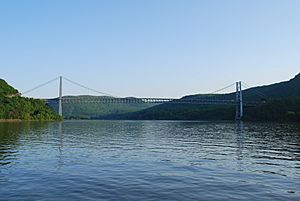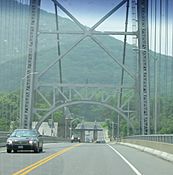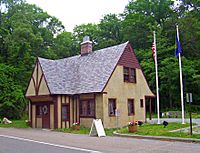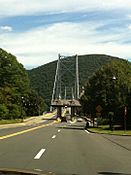Bear Mountain Bridge facts for kids
Quick facts for kids Bear Mountain Bridge |
|
|---|---|

Bear Mountain Bridge in 2009
|
|
| Carries | 2 lanes of |
| Crosses | Hudson River |
| Locale | Cortlandt / Bear Mountain |
| Other name(s) | Purple Heart Veterans Memorial Bridge (ceremonial) |
| Maintained by | New York State Bridge Authority |
| Characteristics | |
| Design | Suspension bridge |
| Total length | 2,255 feet (687 m) |
| Width | 48 feet (15 m) |
| Height | 360 feet (110 m) |
| Longest span | 1,632 feet (497 m) |
| Clearance below | 155 feet (47 m) |
| History | |
| Opened | 1924 |
| Statistics | |
| Daily traffic | 17,695 (2007) |
| Toll | (eastbound only) cars $1.75 cash, $1.35 E-ZPass |
|
Bear Mountain Bridge
|
|
| Location | Cortlandt / Bear Mountain |
| Built | 1923 |
| Architect | Baird, Howard C.; Terr & Tench Construction Co. |
| MPS | Hudson Highlands MRA |
| NRHP reference No. | 82001266 |
| Added to NRHP | November 23, 1982 |
The Bear Mountain Bridge, also known as the Purple Heart Veterans Memorial Bridge, is a special type of bridge called a suspension bridge in New York State. It crosses the Hudson River, connecting Bear Mountain State Park in Orange County with Cortlandt in Westchester County.
When it was finished in 1924, it was the longest suspension bridge in the world! This record was broken just 19 months later by the Benjamin Franklin Bridge. The Bear Mountain Bridge is unique because its side sections are supported by their own structure, not by the main cables.
This bridge helps connect important roads like the Palisades Interstate Parkway and US 9W on the west side. On the east side, it connects to NY 9D and US 9. It's also part of the famous Appalachian Trail and New York State Bicycle Route 9.
The bridge has two lanes for cars, separated by a double yellow line. There are also walkways on each side for people to walk or bike. If you're on a bike, you can ride on the road or walk your bike on the pedestrian path.
Contents
History of the Bear Mountain Bridge
Early Bridge Ideas
People started planning a bridge in this area way back in 1868. The idea was to build a "Hudson Highland Suspension Bridge" to carry a railroad. This railroad would bring coal and iron to factories. News reports from the late 1800s kept saying the bridge would be built soon, but tough economic times made it hard to get the project going. A plan for the bridge finally expired in 1916.
Building the Bridge
In March 1922, a private company called the Bear Mountain Hudson River Bridge Company was created. Their job was to finally build the bridge. The company raised money to start construction.
Bridge Completion
The Bear Mountain Bridge officially opened on November 27, 1924. It was a huge achievement! It became the longest suspension bridge span in the world at that time. It was also the first suspension bridge to have a concrete road surface.
This bridge was the first one built for cars to cross the Hudson River south of Albany. The way it was built helped engineers learn new things for even bigger projects. These lessons were used for famous bridges like the George Washington Bridge (built in 1931) and the Golden Gate Bridge (built in 1937).
New York State Takes Over
The New York State Bridge Authority took over the bridge on September 26, 1940. They lowered the toll (the fee to cross) to 50 cents per car. At first, tolls were collected when cars went in both directions. But in 1970, they changed it so tolls were only collected when cars traveled eastbound. This meant eastbound drivers paid double, but westbound drivers paid nothing. Many other bridges in the area also switched to eastbound-only tolls around that time.
In 1982, the bridge and its old toll house were added to the National Register of Historic Places. This means they are important historical sites. The bridge was also recognized as a local historic landmark in 1986.
Today, the toll for a passenger car is $1.75 if you pay with cash, or $1.35 if you use E-ZPass. Remember, you only pay if you are driving eastbound!
New Ways to Keep the Bridge Safe
The Bear Mountain Bridge has been used to test new materials. These materials help lower the cost and environmental impact of keeping the bridge's cables in good shape.
Bridge cables are made of many strands of wire. To check them, inspectors look for moisture and rust. For over 100 years, a special "red lead" paste was used to protect the cables from water. But this paste was not good for the environment and would crack after a few years. This meant a lot of ongoing work to fix it.
In the 1990s, engineers tried new materials on a small part of the bridge's cables. After a year, they found a new, safer material that worked much better. This new material is a special type of paste that doesn't crack easily. In 2000, the bridge cables were rewrapped using this new material. Seven years later, the cables were still in great condition, with no new moisture or rust. This new material could help the cables last longer and reduce how often they need to be checked and fixed.
Gallery









